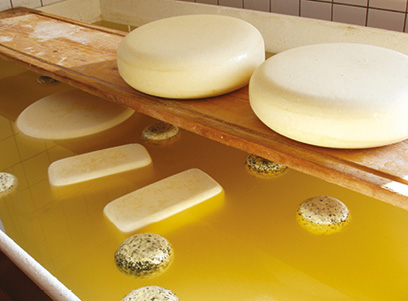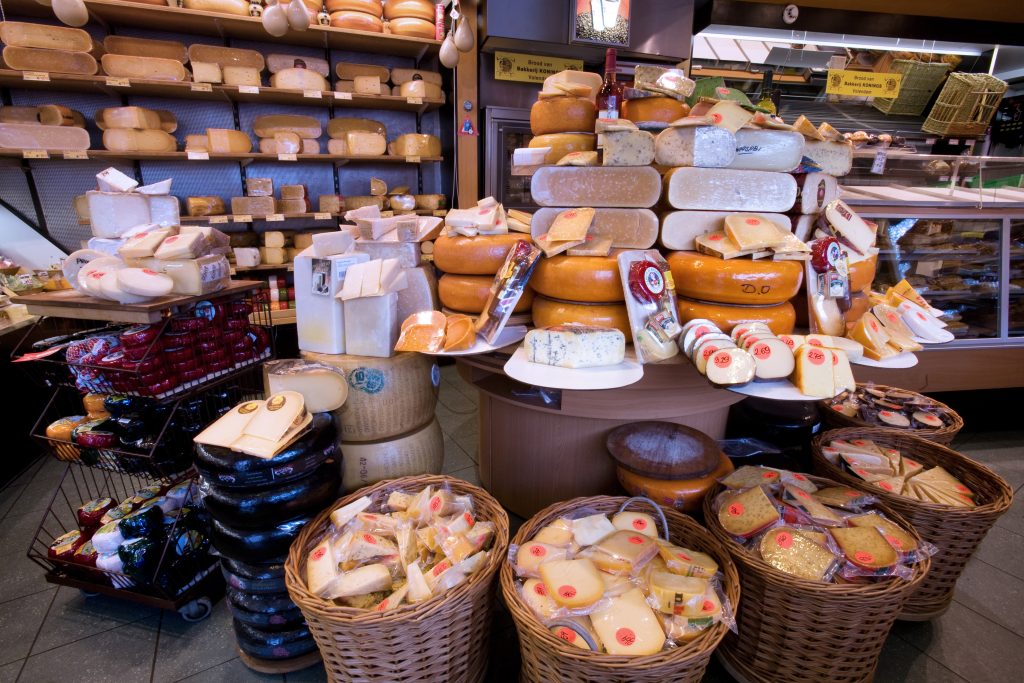
WHERE TO FIND EUROPE'S BEST CHEESE SOURCES ON A SMALL SHIP OCEAN OR RIVER CRUISE

In these days of drive-through, prepared food, it is refreshing to find food cultivation, preparation and consumption cultures still awash in old-world traditions.
CruisinwithTed.com has culled from some excellent posts on some of Europe’s best culinary tours featuring cheese which you can use to help plan your next cruise.
Cheese, A European Tradition
Cheese is synonymous with Europe. Parmesan and Mozzarella from Italy, Gouda from the Netherlands, Danish Blue from Denmark, Brie and Camembert from France, Feta from Greece; the list goes on. In fact, European countries dominate both the world’s production and consumption of this popular food. The Greeks, French, Swiss and Danish are among the high cheese consumers, whereas the Hungarians and Irish eat the least.
Cheeses fall into several categories, but irrespective of type, all cheese making requires the separation of milk into solid curds and liquid whey. This usually involves souring the milk with bacteria and adding rennet, which firms the resulting curds. This, however, is where uniformity ends. From here, a cheese may be washed, drained, heated, stretched, aged or ripened, depending on the desired end product. For example, heating and ageing produces a hard cheese, stretching gives us mozzarella and ripening produces the delicious array of brie, camembert and blue cheeses.
Best Briehviour: A Guide To French Cheese Etiquette
Our cheese journey journey begins in France, a country that has a cheese tradition that is so rich, Charles DeGaulle said of it: “How can anyone govern a nation that has two hundred and forty-six different kinds of cheese?” A French proverb claims, “un fromage par jour de l’année” – there is a different cheese for every day of the year. It depends on who you ask, but that number is probably low: between cow, goat, and sheep cheeses, there are more than 400 different varieties.
The French consume about 53 pounds of cheese per person annually (second only to Greece, at 68 pounds per capita each year.) In France, the cheese course is served just before, or more often, instead of dessert. It not only helps with digestion, it gives you a great opportunity to sample the tasty regional cheeses — and time to finish up your wine. When visiting a restaurant or shop which offers cheese try these: a hard cheese (such as Cantal), a flowery cheese (such as Brie or Camembert), a blue or Roquefort cheese, and a goat cheese.

And don’t forget to keep these rules in mind when serving/consuming cheese in France:
- No Crackers And Cheese – The French will think you’re crackers, if you serve the cheese with anything other than bread. Although it doesn’t always have to be baguette. They believe that crackers take away from the taste of the cheese you see. So keep your selection box well hidden for when you’re on your own.
- Save Some Wine For The Cheese – It would be a major faux pas if you had gone through all your vin rouge and had no red left for the cheese course. In general red wine is served with cheese in France, though not always.
- If you’re the one putting together the cheese plate, keep in mind that there should always be an odd number of cheeses, for aesthetic purposes. And in order to maintain balance in the universe, there should be a minimum of three varieties: a soft cheese, a hard, and one blue or goat cheese.
- Small piece of bread, small piece of cheese – Don’t go plopping a whole wedge of cheese on a hunk of bread like some kind of savage. Think small piece of bread, small piece of cheese. Just gently place the morsel of cheese on the bite-sized morsel of baguette. And resist the urge to spread the cheese — it’s not Nutella.
- Like wine, cheese needs to breathe – Cheese that has been cooped up in its wrapping in the fridge is not immediately ready to be eaten. Instead, take out the cheese and prepare it on a plate at least an hour before it’s meant to be eaten. Room temperature is where those delicious aromas and flavours really thrive.
- Cheese is not an appetizer – First of all, serving cheese as an appetizer before dinner like Americans often do is unheard of in France. And you won’t see it on a cocktail stick with a pickled onion and tomato. In fact serving cheese at any time of the day or night is a non non. Just stick to its allotted slot in a meal which is…
…Before dessert – In the UK, finishing a meal with cheese and grapes is quite common, but in France they wouldn’t finish a meal with cheese and their reasoning is sound: just think how smelly some of their most famous fromages are. Imagine all your dinner guests continuing to debate the invasion of English into the French language with deathly Camembert breath. They’d be laid out on the floor.Which is why the French always follow cheese with some kind of dessert, which could even be grapes. So don’t serve them together.
Copyright: Katie Warren www.thelocal.fr
Get the Most Vacation Protection for Your Dollar!

You should have a half a million to a million dollars in coverage. As cruise line insurance usually covers only $20,000 to $50,000, be prepared for astronomic out-of-pocket expenses when making a claim! Fortunately professional Travel Advisers like myself provide coverage for up to A MILLION DOLLARS
Normandy, France: Where Cheese Is A Long Honored Tradition
Normandy, the pasture and orchard region of France, is best known to Americans as the site of the Allies’ D-Day invasion of Europe.
Rouen, A Historical Delight.
But it is also a French epicurean delight. And Rouen, its famous robust and medieval city, its heart. This is a city of historic significance with plenty to see and experience.
Hugging the banks of the Seine as it meanders to the Channel, Rouen is a city of half-timbered houses, Gothic churches, historical richness, wonderful locally sourced food, and friendly people.
Called a museum-city by its tourism office, Rouen was bombed extensively during World War II in the Battle of Normandy. But the old town, the medieval soul of the city, remains surprisingly intact. The Place du Vieux Marché where Joan d’Arc was burned, the Gros Horloge (great clock) looking down on bustling streets, city hall, and Rouen’s magnificent cathedral lure visitors and locals alike. Rouen’s cathedral, interpreted by Impressionist Claude Monet, is as imposing and spectacular as it was in Monet’s day. It’s among the most-photographed Rouen tourist attractions and deservedly so.

But Normandy is best known for its dairy and many of its wonderful small-farm cheeses never make it out of France since the production is so small and artisanal. In Normandy, food shops, confectioners / chocolatiers, and restaurants highlight locally sourced ingredients and products. Travelers here keep in-mind Normandy’s three “Cs”: cheese, cider (which in France, is always “hard”) and calvados. There is plenty to see and do in Normandy, here is a guide to some of the highlights.
You’ve got to buy local caramels while in Normandy and in many of Rouen’s small confectioners you can watch as they’re being made. Here, the shops feature Normandy’s prized locally-sourced ingredients and products … one after another of cheese shops, caramel crafters, macaron makers and meats. Spend one day simply going from small shop to small shop, browsing through the inventory of sweets and cheeses. If you love food or just love to eat, Rouen is paradise.
Camembert of Normandy France, the Cheese Lover’s Cheese.
Camembert ranks as one of France’s most popular cheeses, an impressive fact considering it has only been around since the late 18th century (compared to 11th century Roquefort or the ancient 1st century Cantal). Camembert is similar to Brie in shape and appearance, although most Camembert Cheese has a slightly stronger flavor and more noticeable aroma than Brie. This soft ripened, bloomy white rind cheese is sold in small wooden boxes which help to protect its soft, creamy texture during shipment.
Camembert Cheese is native to Normandy, a northwestern region of France on the coast of the English Channel. Normandy (or Normandie in France) is famous for producing some of the richest milk in all of France. Because of this, butter and cheese from Normandy has long been praised for their sublime flavor. Camembert’s flavor is a product of terroir, where its taste is intrinsically connected to the land the cows graze on.
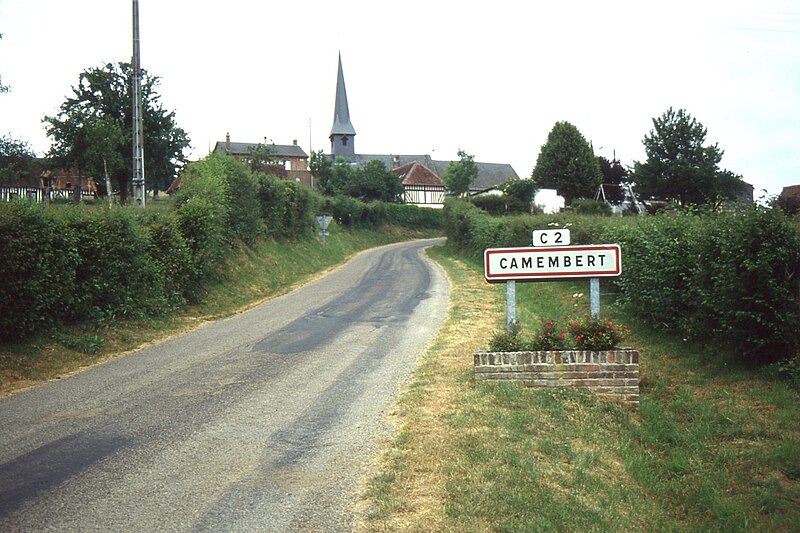
In the small town of Camembert, in Normandy, there is a statue in the honor of Marie Harel, who is credited for inventing camembert cheese. In 1791, the farmer molded curd milk with a ladle, creating the very first camembert.
While that was the first instance of camembert, it wasn’t until 1850 that the cheese became widely known. That’s when the French railroad from Paris to Caen, via Lisieux, opened and brought camembert to other areas of the country.

Soon, Napoleon III tasted it and immediately fell in love with the flavorful fromage and began regularly asking for it. Napoleon was reputedly served the cheese, and liked it so much he kissed the servant girl who served it to him. Marie’s son took up making the cheeses, but he moved back to his mother’s home town: Camembert. In 1863, Napoleon III was served the cheese, and he liked it as much as his ancestor did. He asked where it came from and was told, Camembert, and he replied, “Well, then, from now on it will be known as Camembert!”
Word spread quickly, as the railroad connection between the Normandie region and Paris offered many new outlets and opportunities for people to try the camembert.
The production of camembert began to increase drastically, as the delicious fromage made its way around the country.
Copyright: Donna Manz neverstoptraveling.com
Rouen Farm & Countryside: Viking River Cruise, optional Excursion.
Visit the the Domaine Duclos Fougeray, a beautiful rustic farm whose 18th-century buildings are made from stone, mud and timber. The owners have been making award-winning cider and other products here for more than two decades and invite you to visit the orchards and watch a lively shepherd dog demonstration. During your visit, you will sample calvados and its close cousin pommeau with homemade apple tart and Norman cheeses. After time to savor your snack and the glorious setting, return to your ship.
MAKE YOUR VIKING CRUISE A TRULY MEMORABLE EXPERIENCE FROM START TO FINISH

Saint Tropez, France – Center For Goat Cheese Production
Saint Tropez is a genuine discovery for tourists admiring ethnic cuisine of Provence. The city features plenty of upscale gastronomy establishments meeting sophisticated tastes of the genuine connoisseurs and fastidious gourmands. Exotic and unusual treats admirers will love the Mesclun salad made of flavoring herbs and dandelion greens meanwhile hot treats fans will love pasta added with anchovies and green olives. True meat dishes gourmands will surely love to try beef stewed in wine sauce and stuffed leg of lamb.
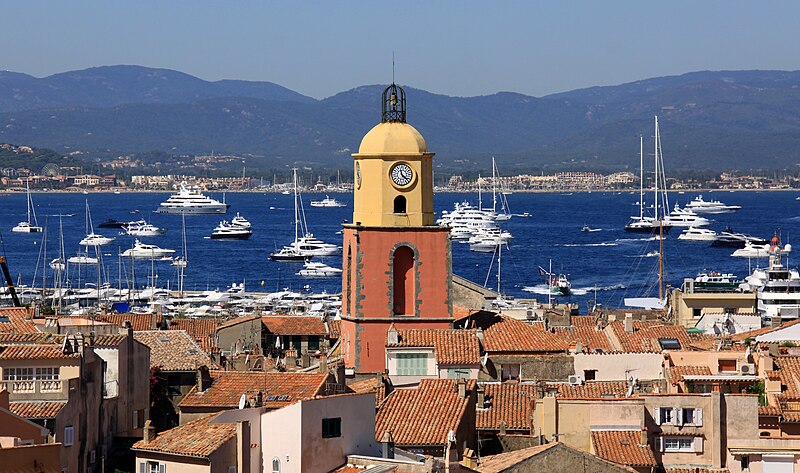
One of the most popular ethnic dishes is a thick clear soup named the Bouillabaisse made of various seafood. Each cook has a secret recipe of this treat preparation. The soup may be added with shellfish, mullet, short-horn sea scorpion, Lophius and other exotic fishes. The most popular snack served in local restaurants is cheese which is served being added only with wine.

The city of Saint Tropez is known for goat cheese production. These cheese sorts can be ordered and tried in local eating establishments as well as can be bought at local markets where tourists will also find soft cheese made of cow and sheep milk.
Saint Tropez offers plenty to see and do as covered in this article from the New York Times: 36 Hours In St.-Tropez.
Copyright www.orangesmile.com

Best of St. Tropez & Suroundings: Viking Ocean Cruise, optional excursion
This is a wonderful tour of France’s most picturesque coastal town. We highly recommend this tour to this quaint whinery featuring lushly landscaped scenery and amazing wines and goat cheese tastings. Sample their Merlot, the la Source, le Blanc, the Rose and their sparkling white wine.
Stay Up To Date With the Latest Travel Deals and Tips Like My Facebook Page CruisinWithTed
The Netherlands, A Cheese Lover’s Dream
The Netherlands is known for its cheese, amongst other things, and there is no question about why this is, once you discover that the history of cheese making in the region stretches back over 1600 years. The geography of the country lends itself perfectly to cheese production, as there are plenty of grazing pastures in which the dairy cows can feed. Many Dutch specialist cheese require that only milk from Dutch, pasture-fed dairy cows be used.

With hundreds of years of experience to back them, it is no surprise that the Netherlands are one of the leading cheese exporters in Europe, and that the industry has a turnover of around Euro 7 billion per year. There are a lot of different types of cheese in the Netherlands, including goat cheeses and sheep cheeses. Here is some useful information about some of the Netherlands most famous cheese:
Gouda
Gouda is one of the most widely produced cheeses in the Netherlands, accounting for around 50% of the country’s cheese production and of course originates from the city Gouda. Historians have actually found references to the cheese which date back to the end of the 12th Century, making it one of the oldest distinct types of cheese in the world which is still in production.
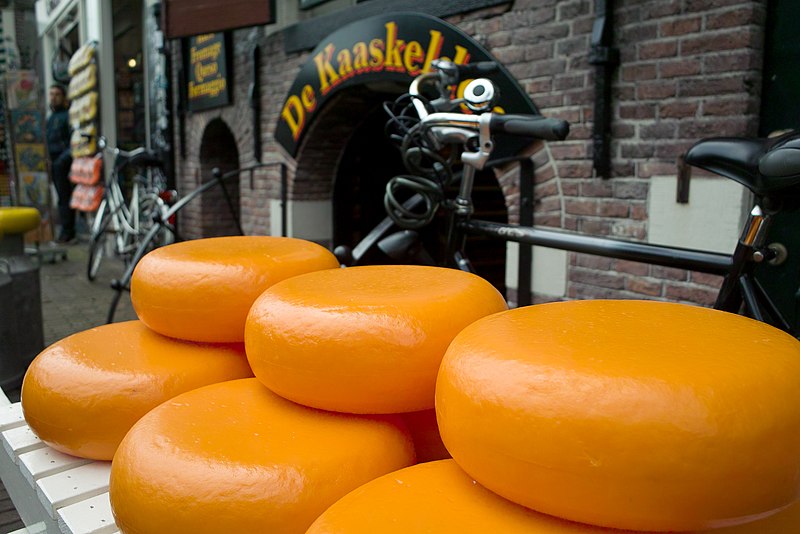
It is usually classified as a semi-hard cheese, and has a milk fat content of around 48%. Some Gouda can be aged for over 12 months to help to develop its flavour. Whilst young Gouda cheese is well suited to sandwiches, cubes of matured Gouda are often eaten with Dutch mustard as a snack.
Edam
Edam accounts for around 27% of the total cheese production of the Netherlands. It is famous for its Cheese Markets. Due to the fact that it both ages and travels well, it was the world’s most popular cheese between the 14th and the 18th Century. It was possible to take this cheese on long voyages without it posing significant health risks.
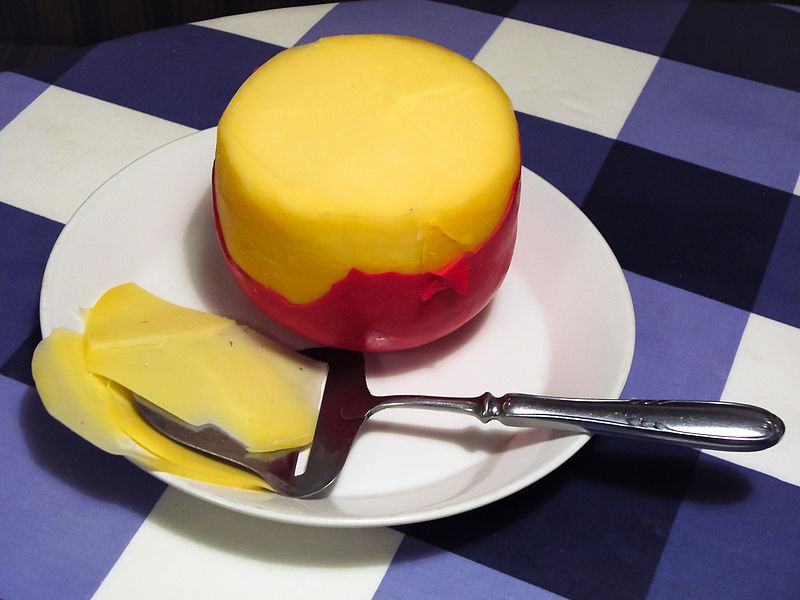
Edam is softer than many other Dutch cheeses, because of its lower milk fat content (around 28%), however this also makes it largely unsuitable for toasted sandwiches etc.
Copyright http://www.netherlands-tourism.com/
Viking’s Rhine Getaway is a Perfect Choice for Your First River Cruise.

Rhine Getaway
8 Days | Amsterdam to Basel
up to FREE Air*
To get up to free air on this incredible journey, run of the ship offers, up to $500 pp in non-cash amenities please call this number: 954-290-8626 or email
hello@cruisinwithted.com
Kinderdijk Windmills & Dutch Cheese Making: Viking River Cruise, optional Excursion
Ed Lallo/Newsroom Ink has a great review of this tour: Viking River Cruise Tour of Kuiper Dairy and Cheese Farm
“It’s hard to imagine Holland without its lush green pastures filled with black-and-white Frisian cows, so from Kinderdijk’s windmills it was off via bus to tour the cheese and the Kaas-en Zuivelboerderij Kuiper dairy farm.

“The Kruiper’ agricultural company is integrated into a variety of different revenue sources; the cheese factory, livestock and a retail shop where their Giessenlander cheese products are sold.The busload of Viking River Cruisers learned that like earlier farmers in this region, the Kruipers’s ancestors lived in the village close to the church. Their current cheese farm, built in 1975, stands on Heideweg road, a watery “badland” locals referred to as a “hei.”
“Though not producing cheese the day of our tour, Thera explained the process and equipment as we toured the factory. Making cheese consists of two aspects: cheese production… and all the work around it. Thera ensures problem-free production and develops the family’s unique recipes. Jan runs the farm. Their whole operation consists of a tight team of three women and three men.
“Our tour guide said that almost half of the cheese production in Holland is devoted to Gouda and it comes in a ridiculous variety of flavors. The semi-hard cheese with 48% milk fat content ranges from mild to piquant in taste. The flavor gets stronger as it ages, reaching full maturity in two to three years.
“After sampling a variety of their wares, and purchasing almost as many (note: you can bring cheese through customs into the U.S. as long as it is vacuum packed), it was off to visit with Jan and learn about the family’s cows.
“After carefully navigating landmines in the the cow barn, the group gathered around Jan in front of a cow about to go into labor.
“Cows are creatures of habit,” explained Jan standing in a barn filled with the scent of cows, hay and other somewhat foul aromas. “If one of our cows is late for the milking, then I know there’s something wrong. This is extremely painful because our cows, they are our team. We take care of them the best we can. Because what you give, you get back in return. Good care and good food create good milk. Good milk is the perfect base for our cheese.”
“Land and labor are expensive in northern Europe. To compete, the scientific community, businesses and government work closely to boost productivity. Dutch cows currently produce twice the milk they did in 1960. The result is the value of the country’s agricultural exports is second only to the US, a country 200 times the size.
“The country not only exports its cheese, but also its cows and expertise to foreign farmers. Standing in front of three new calves, Jan said he sells excess calves and cows to farmers located outside of the country, mostly in the Middle East.”
Copyright: by Ed Lallo/Newsroom Ink
Read my informative blog on Ocean Cruise Packing and Preparation: OCEAN CRUISING ESSENTIAL PACKING TIPS.

Rules About Importing Cheese
The U.S. government is very strict about what sorts of cheese can come into the country. The Department of Agriculture does not approve any cheeses that are unpasteurized or that have been aged less than 60 days. The U.S. Customs and Border Patrol notes that most “cured” cheese is admissible as long as it is for personal use.
The CBP allows solid cheese that is hard or semi-soft and does not contain meat, as well as butter, butter oil and cultured milk products like yogurt and sour cream. Mozzarella and Buffalo mozzarella are also permissible. Check if the cheese you’d like to import is pasteurized or processed. Anything that isn’t should be left behind.
Packing Cheese for the Airplane
Passengers can bring certain cheese onto the airplane in their carry-on bags. Because the cheese likely won’t be refrigerated for several hours, especially if you’re on an overseas flight back to the states, it’s important to wrap the cheese carefully. Aged, hard cheeses, like Parmigiano-Reggiano, are easier to travel with. These cheeses have less moisture, so they should be fine out of the fridge for at least a day. Soft cheeses, like mozzarella, need more care. Wrap them thoroughly in air-tight containers and keep them in the top of your luggage. Give everything an extra layer of plastic in case there is spillage. Check with your airline in advance for any specific restrictions.
Taking Cheese Through Security
There are typically no issues taking solid foods through security at the airport, both in Europeand in the U.S. However, travelers should be aware of how much liquid is in a container of cheese like Buffalo mozzarella, which is often stored in water. Be sure the liquid is a permissible amount for a carry-on bag, usually 3 oz. Prepare to take out any packed cheese to show security in case there is an issue.
If you’re really dying to munch on that unpasteurized cheese you bought in Rome, there is one exception that will allow you to travel with it. Since passengers can’t bring unpasteurized cheese through U.S. Customs, the best way is simply to consume the cheese before you get to the American border. Chow down on the cheese in the airport or on the plane (although if it’s a particularly smelly cheese be prepared for angry neighbors). It’s not worth the risk of trying to sneak it past U.S. Border Patrol, so always ensure that your souvenir cheese will be allowed into the country when you buy it – if not, you better eat it quickly.
Copyright: Emily Zemler, Leaf Group, USA Today
Read my informative blog on Paris, What to See and How To Do It: THE BIGGEST LITTLE ROAD TOUR IN PARIS.
Learn More About Foreign Power Adapters In My Blog: THE INTERNATIONAL POWER TRIP: SOLVED.
Change Your Local Currency To Foreign The Smart Way, Study My Blog: HOW TO AVOID ADDED CURRENCY FEES WHEN TRAVELING ABROAD
email:hello@cruisinwithted.com
or call 954-290-8626.

